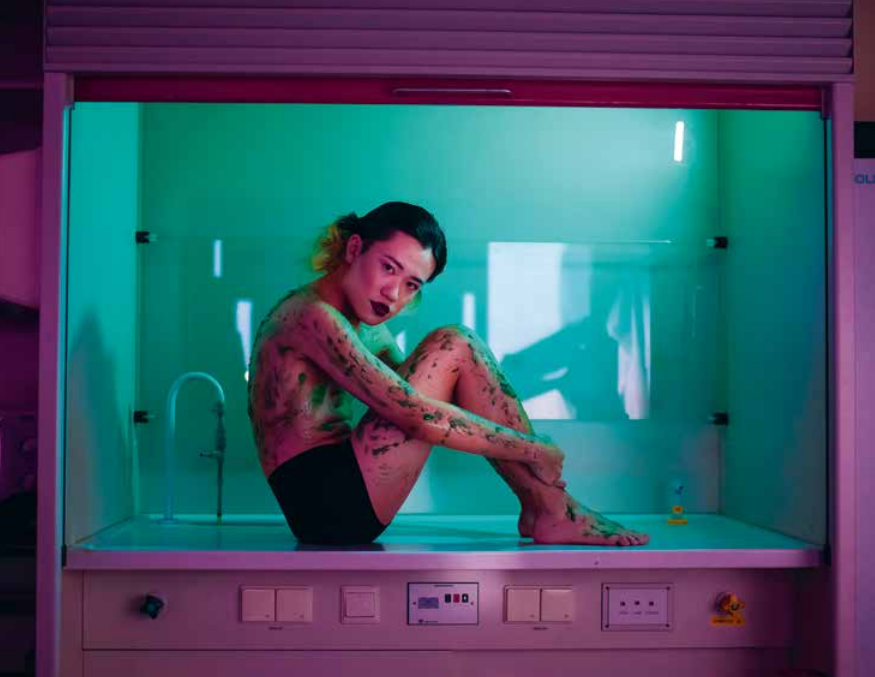
Categorieën: kM 126
Tags: Artscience en VU
A lab at the VU, specially designed for artists and scientists. How did it come about? Why artscience? An essay on the social and artistic value of art-science collaborations, such as with the European Space Agency (ESA) and about black holes, an algae-eating robot and artificial intelligence.
This article is from kM #126 Art & Science. Scroll down to read the full article.
What is artscience?
RAOUL N. FRESE A lab at the VU, specially designed for artists and scientists. How did it come about? Why artscience? An essay on the social and artistic value of art-science collaborations, such as with the European Space Agency (ESA) and about black holes, an algae-eating robot and artificial intelligence.
When you walk into room M553 at the Vrije Universiteit on the fifth floor of the Mathematics and Physics (WN) building, you see at first glance an average chemistry laboratory. The space, about two hundred square meters, is intersected with long, high tables, called benches, which are perpendicular to the long window side. Under the benches, cabinets, above them narrow tables. On top of all this, chemical glassware, erlenmeyer flasks, beakers, graduated cylinders, test tubes, and many bottles on which the contents are described with marker. You will also find microscopes, pH meters and mixers, and a dress made of vegetable leather. Further on is a large aquarium and between the glassware a stack of books. On a table pictures of a queer fashion show and in a corner, by the window, plants linked to a kind of analog synthesizer from which electronic dance music is generated….
You are in the artscience laboratory of the undersigned, physicist at the VU, specializing in biophysics of photosynthesis. You can meet artists and scientists, designers and students from art academies, colleges, or universities. It is a somewhat unusual lab, and a very unusual studio, specially equipped for art and science collaborations. We prefer to merge the two into something new: artscience. But how do you do that? And what is that artscience?
artscience
There is no clear answer, and certainly not when the lab was just set up. It went like this: in 2016, the Demonstrator Lab programme was launched at the VU physics, which was announced as spaces and support for start-ups and activities from science, which aim to create ‘value for society’.
I had just visited Brazil with artist Ivan Henriques, where his work was shown, including Symbiotic Machine that we had created together, an algae-eating floating robot [1] based on my research on bio-solar cells [2]. In Rio de Janeiro, where the exhibition took place, it was then policy that at each exhibition also an educational program was made especially for children from shelters. These children are often either orphaned or taking refuge from the violence in Brazil. They often cannot read or write. I noticed that these children could easily pay attention to the works over two hours, and that they found it special that we paid attention to them. This experience was in the back of my mind when I read the announcement and went to the director of Demonstrator Lab, Davide Lannuzzi, convinced that art-science collaborations certainly create value for society. The value is opaque though.
Engaging young people from a world as diverse as Rio’s slums and Amsterdam’s childcare is a value. The work can start as a work of art and then become a research object, or a speculative design from which an application arises. Work from the lab has even been shot into space to the International Space Station, as art in space. It is also a way to link exact scientists to the humanities, with artists as a bridge between them.
Artists
Artist duo Dmitry Gelfand and Evelina Domnitch are at the forefront of art science and have been involved in the lab from the beginning. They are winners of the prestigious art + technology prize Witteveen + Bos and physics is their canvas. Their works are often physics research constellations not used to obtain data but applied to make fundamental natural phenomena visible to the public. For example, the aforementioned aquarium is a large container of water in which vortices can be generated and their dynamics and interaction become visible by illuminating the vortices with a laser projected to the ceiling [3]. The physical-mathematical description of such dynamics is remarkably similar to that of black holes in the universe and so you as a human being can visually experience the merger of black holes.
With a completely different setup, this phenomenon was measured in 2018, as a sound wave deep in the ground. This sound has been incorporated into a composition by sound artist William Bassinski [4] and together with the projected images it gives a visual-auditory experience of this natural phenomenon using physical instruments. While there is nothing as violent as the merging of black holes, except for the Big Bang, the space with projections of dynamic patterns and noise music is remarkably soothing.
VU Amsterdam has a special art policy, with its own collection and curator, and recently also its own gallery. Visual artist and photographer Simone Hoang was commissioned in 2018 for a work that was purchased for the collection. Hoang edits photographic paper and illuminates it directly to create a dynamic color pattern. She did a short study in the lab where the work of Domnitch and Gelfand was under revision at the time. Together they saw opportunities to capture the dynamics of vortices projected on the ceiling by stretching paper there and having it illuminated directly and very briefly [5].
NWO
The start of the lab was helped by a project grant from the Dutch scientific organization NWO. This allowed Henriques, Gelfand and Domnitch to be appointed as temporary employees in the physics department for a postdoc. The theme of the funding round was Research through design. This methodology is a reversal of the usual sequence: first research and prototyping, and then design. This was first design and before that developing the technology and knowledge. The project was conducted at the VU together with art academy Willem de Kooning and the European Space Agency ESA and involved research into devices that can purify the air and generate electricity with bio-solar cells made of algae.
Algae are an essential component for sustainability, in space and on Earth, and through the ESA, another biomaterial was investigated for application with algae together: bacterial cellulose, a substance made in the fermentation of tea to make kombucha. Kombucha cellulose is an alternative to cellulose from plant or tree and can be processed into clothing or other fabrics or packaging material. Eventually, the result was exhibited at various locations in Amsterdam [6] and in the aforementioned International Space Station ISS, as part of the Moon gallery [7].
Freedom
An art science lab can be seen as a leeway, in which freedom reigns, serendipity is possible, and research is not tied to disciplines or theoretical models. But also, as a place where science and art shed their thematic feathers and we can look further with an open mind. We are confronted with radical technology when commercial parties bring it to the market. Can we produce a method in which researchers highlight all the possibilities of new knowledge and technology even before a prototype has been made? Art science is also a way to create a more diverse and inclusive science, one that looks more critically at the consequences of research for society.
For the Bio Art and Design (BAD) Award, artists are paired with scientists. If there is a match, they can submit a proposal for a work. That is how artist Michael Sedbon ended up at the art science lab. And with him came, crate after crate, electrical components from Shenzhen, China, the electronics hub of the world. In three months, he made an artscience equivalent of the Sistine Chapel in the lab: a giant installation of algal bioreactors, interfaced by sensors and artificial intelligence, which determined which bioreactor was entitled to a dose of light from a movable lamp. The exhibition at MU Hybrid Art House, Eindhoven, looked alien-like [8]. There was no room left for man in this techno-dystopia. The exhibition lasted three months. By the end, every reactor was bleached, there was no algae left alive.
Conclusion
In recent years I did a residency with Malian filmmaker Manthia Diawara. Commissioned by organizer Gluon, we looked for the value of artificial intelligence for Africa. This eventually led to the documentary film, African Intelligence (2022) in which Diawara shows the search, not so much for answers, but for confrontations with that which is lost. In an earlier film by Diawara, Édouard Glissant: one world in relation (2010), the philosopher Glissant describes his understanding of opacity, as a right to opacity. He contrasts that notion with systems thinking and classification, the tendency to deduce everything to belonging to a specific group. I realize that this is also what defines our trans-disciplinary research. Artscience must be opaque.


